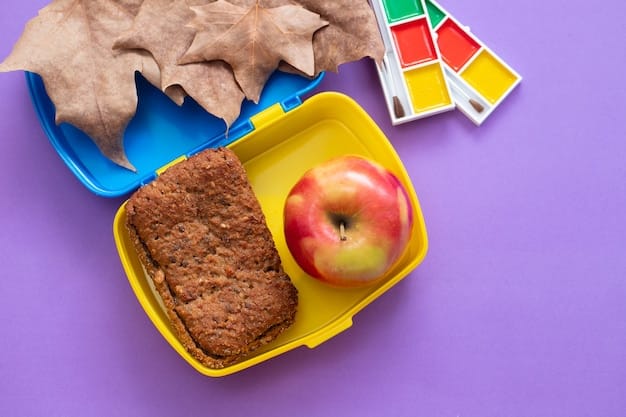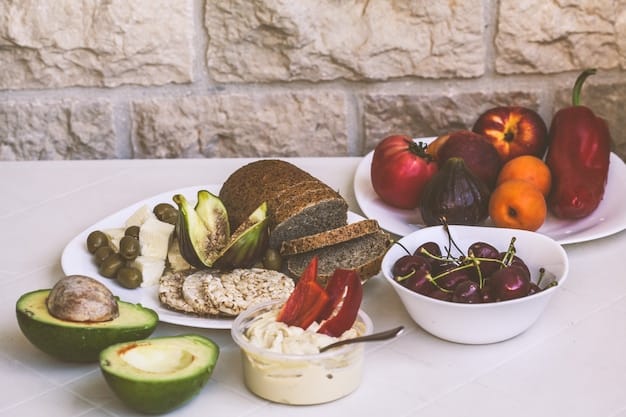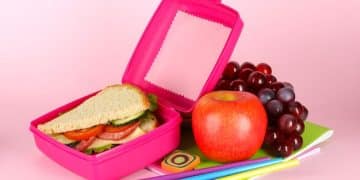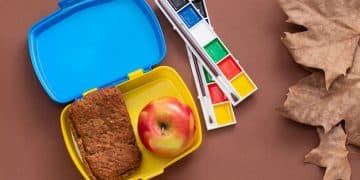Allergy-Friendly Lunchbox Ideas: Safe School Lunches in 2025

Allergy-friendly lunchbox ideas for 2025 require careful planning and ingredient selection to ensure children with allergies can enjoy safe and nutritious meals at school, focusing on avoiding common allergens and using creative substitutions.
Sending your child to school with a packed lunch is a great way to ensure they’re eating healthy and staying safe, especially when managing allergies. As we look ahead to 2025, preparing allergy-friendly lunchbox ideas requires some planning and creativity to keep your child safe and happy at school.
Understanding Common Allergies in Children
Understanding common allergies is the first step in creating allergy-friendly lunchboxes. Protecting a child with allergies means more than just packing food; it means understanding what substances can trigger reactions and meticulously avoiding them.
Top Allergens to Watch Out For
Several allergens are frequent culprits in childhood allergic reactions. Awareness of these can significantly reduce the risk of accidental exposure.
- Peanuts and Tree Nuts: Often the most severe, requiring strict avoidance.
- Dairy: Common in younger children; many alternatives are available.
- Eggs: Found in numerous baked goods and prepared foods.
- Soy: Present in many processed foods and sauces.

Careful label reading is crucial when choosing ingredients for your child’s lunchbox. Become familiar with alternative names and hidden sources of allergens.
Planning Allergy-Friendly Lunchbox Menus
Designing a menu that is both safe and appealing can be fun and creative. With some careful planning, you can ensure your child enjoys a variety of delicious meals without the worry of allergic reactions.
Creative and Safe Meal Ideas
Variety is key to keeping lunchboxes exciting. Try different combinations and themes each week.
- Gluten-Free Wraps: Fill with sliced turkey, avocado, and lettuce.
- Rice Noodle Salads: Add chopped veggies and a sesame-free dressing.
- Quinoa Bowls: Combine with black beans, corn, and a dairy-free cheese alternative.
Snack Smart: Allergy-Safe Choices
Snacks are just as important as the main meal. Opt for single-ingredient snacks like fruits, vegetables, or allergy-friendly bars.

Packing lunches with a variety of safe and tasty treats is a great way to make sure your child feels included. Avoiding common allergens while still crafting something delicious just takes some creativity.
Essential Tips for Preventing Cross-Contamination
Cross-contamination is a significant concern when managing food allergies. Even trace amounts of an allergen can trigger a reaction. Proper handling and preparation techniques are vital.
Kitchen Hygiene: A Must
Keep your kitchen clean and organized to avoid cross-contamination. Dedicated cutting boards and utensils can make a big difference.
- Designated Utensils: Use separate tools for allergen-free cooking.
- Thorough Cleaning: Wash all surfaces and equipment after each use.
- Storage Solutions: Store allergen-free foods in sealed containers away from potential contaminants.
Training your child about the dangers of cross-contamination and how to avoid it is a great way to keep them safe. Empowering them with information is a tool they can use every day!
Reading Labels Like a Pro
Navigating the grocery store when managing allergies can be a challenge. Food labels are your best tool for identifying potential allergens. It takes practice to read labels like a pro, but doing so is essential when ensuring your child stays safe at school.
Understanding Allergy Labeling Laws
Familiarize yourself with the current laws regarding food allergen labeling. These regulations help ensure that allergens are clearly identified on product packaging.
Be vigilant even with products you’ve purchased before. Manufacturers change ingredients, and it’s important to double-check every time.
Communicating with the School
Open communication with your child’s school is essential for creating a safe environment. Share your child’s allergy action plan and ensure school staff are aware of their needs.
Developing an Allergy Action Plan
An allergy action plan outlines the steps to take in case of an allergic reaction. Work with your pediatrician to create a comprehensive plan.
- Emergency Contacts: Provide the school with up-to-date contact information.
- Medication: Ensure epinephrine auto-injectors are readily available and properly stored.
- Training: Confirm staff members are trained in administering epinephrine.
Schedule regular meetings with teachers and school nurses to review your child’s allergy action plan. These meetings can help ensure everyone is on the same page and can discuss the best ways to keep your child safe.
Packing the Perfect Allergy-Friendly Lunchbox
Choosing the right lunchbox and packing it effectively can contribute to food safety. Insulated lunchboxes and proper food storage are key.
###Choosing the Right Lunchbox
Select a lunchbox that is easy to clean and maintain. Look for insulated options to keep food at safe temperatures.
Proper packing techniques are great for preventing spills and keeping food fresh and appealing. Make sure to keep hot foods hot and cold foods cold!
| Key Point | Brief Description |
|---|---|
| 🍎 Allergy Awareness | Know common allergens like peanuts, dairy, and eggs. |
| 📝 Menu Planning | Create varied, safe menus with ingredient substitutions. |
| 🧼 Cross-Contamination | Avoid allergens during prep using separate tools. |
| 学校School Communication | Share allergy info with school staff. |
FAQ: Allergy-Friendly Lunchbox Ideas
▼
Common allergens include peanuts, tree nuts, dairy, eggs, soy, wheat, and sesame. Always read food labels carefully to ensure these allergens are not present.
▼
Use separate cutting boards and utensils for allergen-free foods. Thoroughly clean all surfaces and equipment after each use. Store allergen-free foods in sealed containers away from potential contaminants.
▼
Try gluten-free wraps with sliced turkey, rice noodle salads with sesame-free dressing, or quinoa bowls with black beans and dairy-free cheese. There are lots of options for main dishes and snacks!
▼
Open communication with the school is essential. Share your child’s allergy action plan and ensure school staff are aware of their needs. Regular meetings can help ensure everyone is on the same page.
▼
An allergy action plan should include emergency contacts, information about your child’s prescribed medication, and steps to take in case of an allergic reaction. Make sure that everyone understands it.
Conclusion
Preparing allergy-friendly lunchbox ideas for your child in 2025 requires careful planning, attention to detail, and open communication. By understanding common allergies, preventing cross-contamination, and working closely with your child’s school, you can ensure they enjoy safe and nutritious meals every day.





